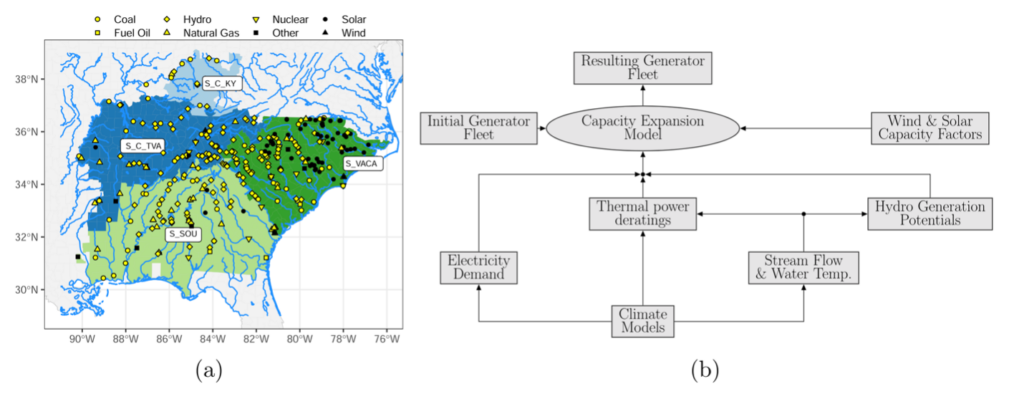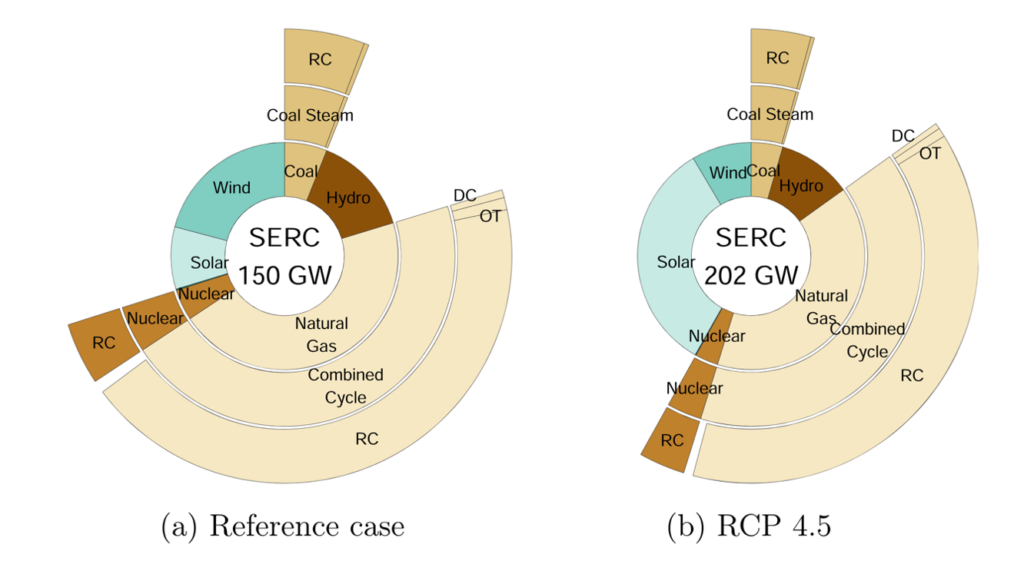Energy Innovation partners with the independent nonprofit Aspen Global Change Institute (AGCI) to provide climate and energy research updates. The research synopsis below comes from AGCI Research Director Julie A. Vano, and a full list of AGCI’s quarterly research updates covering recent climate change research on clean energy pathways is available online at https://www.agci.org/solutions/quarterly-research-reviews
Providing reliable, affordable, and low-carbon electricity in a warming world requires careful consideration of evolving electric energy supplies and demands. For instance, energy demands are likely to shift, reducing the need to heat in the winter and increasing the need to cool in the summer. At the same time, energy supplies are likely to be altered by climate change as shifts in the physical environment – changing water availability and increasing air and water temperatures – reduce the capacity and efficiency of thermoelectric power plant operations, among other impacts. This combination of influences makes planning for power capacity expansion challenging, especially amid ever-increasing pressures to decarbonize.
Typically, climate change risks to electric power supply and demand are investigated separately. A new study led by Fonseca in Environmental Science & Technology takes on both. In so doing, the study highlights opportunities for how long-term energy planning might include a more comprehensive assessment of climate change impacts, and how adaptation and mitigation strategies can converge.
In this study, Fonseca and 10 co-authors evaluate planning for capacity expansion in the U.S. Southeast in 2050. They use a series of models to explore energy mixes that include coal, hydropower, nuclear, solar, natural gas, and wind in the future relative to today. Their multi-model framework captures climate change impacts of an ensemble of future climate change projections. The suite of simulation models they use includes 20 global climate models downscaled, run through hydrologic, streamflow routing, water management, and water temperature models in order to translate global-scale changes to local temperature, precipitation, and streamflow impacts. Streamflows and temperatures from these scenarios are then used to evaluate both hydro generation potentials and thermal power deratings, capturing changes in operation characteristics including power plant efficiency, available power capacity, and water use intensity. The same climate scenarios also drive an electricity demand model. Collectively, this modeling suite provides inputs to the capacity expansion model used to evaluate future energy mixes (outlined in Figure 1b).

The study takes place in the SERC Reliability Corporation (SERC) region, one of North American Electric Reliability Cooperation’s subregions, located in the southeastern United States (Figure 1a). In this region, Fonseca and co-authors find that by mid-century, simulated future climate change increases annual electricity consumption by three percent (Figure 2a) and annual peak demand by 16 percent (Figure 2b), when compared to the reference case. The peak demand changes represent a shift to summer peaks, as opposed to peaks that occurred in both winter and summer. Of note, this demand evaluation focuses only on demand changes driven by climate change; other factors such as population growth are held constant at 2015 levels.


In their analysis, Fonseca and co-authors explore how changes in future demand alter the ideal generator fleet mix. They use an optimization model to determine capacity expansion decisions that configure the power plant fleet to minimize costs while satisfying operating and system constraints. These include measures of capacity and efficiency of thermoelectric power plant operations based on cooling type (e.g., once-through, recirculating, or dry cooling). The optimization model also includes emission reductions requirements, which can be varied as a percentage of total installed power system capacity based on stricter carbon caps.
Through this evaluation, the authors find several notable takeaways that could inform future power planning to avoid costly investment errors. Of note:
- Solar energy is well situated to address changes in demand in the U.S. Southeast. The largest increases in energy consumption due to climate change are in summer peak. Advantageously, solar generation’s seasonal profile matches this demand increase, making it an ideal candidate for increasing future capacity.
- Capacity expansion decisions are nearly identical when either no emission reduction requirements are in place, or when 50 percent reductions are required (generator fleet composition looks similar to Figure 3). This similarity reflects, in part, the high cost of investing in new coal power plants for a large coal generation fleet that is scheduled for retirement and solar power’s advantages during summer peak. When emission reduction requirements are increased to 80 percent, changes are more apparent, including increases in both solar and wind power.
This evaluation, while comprehensive, also comes with caveats. For example, to tease out climate impacts, this study isolates climate change impacts on demand. In the real world, many external factors such as changes in population and economic activity need to be factored in. Transportation electrification is one possible way annual demand could change considerably; estimates range from 25 to 71 percent increases by 2050 (Mai et al. 2018). Another caveat is that climate change may impact solar and wind production, yet the directions of these changes are not clear and are likely to be a smaller impact relative to others in the region.
Given the long lifespans of power system investments, planning should start incorporating climate change effects (Craig et al. 2018). Fonseca and co-authors take a notable step in this direction. They provide a valuable example of an approach to more comprehensively integrate climate risks in long-term electricity planning. This work also illustrates an important win-win in that solar power is both an effective adaptation (helping to reduce summer peak) and carbon mitigation strategy, highlighting positive, no-regret investments.
Featured Research
Craig, M.T., Cohen, S., Macknick, J., Draxl, C., Guerra, O.J., Sengupta, M., Haupt, S.E., Hodge, B.M. and Brancucci, C., 2018. A review of the potential impacts of climate change on bulk power system planning and operations in the United States. Renewable and Sustainable Energy Reviews, 98, pp.255-267.
Mai, T.T., Jadun, P., Logan, J.S., McMillan, C.A., Muratori, M., Steinberg, D.C., Vimmerstedt, L.J., Haley, B., Jones, R. and Nelson, B., 2018. Electrification futures study: Scenarios of electric technology adoption and power consumption for the United States (No. NREL/TP-6A20-71500). National Renewable Energy Lab. (NREL), Golden, CO (United States).
Ralston Fonseca, F., Craig, M., Jaramillo, P., Bergés, M., Severnini, E., Loew, A., Zhai, H., Cheng, Y., Nijssen, B., Voisin, N. and Yearsley, J., 2021. Effects of Climate Change on Capacity Expansion Decisions of an Electricity Generation Fleet in the Southeast US. Environmental Science & Technology, 55(4), pp.2522-2531.